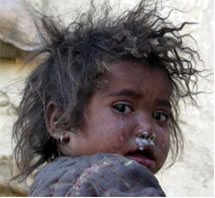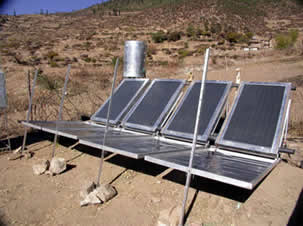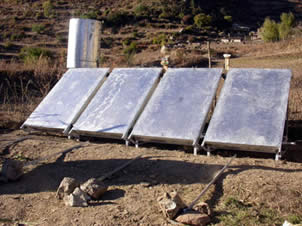| High Altitude Solar Water Heater (HASWH) |
 |
 |
 |
|
About 85 to 88 percentage of the rural population still has no access to any electrical energy services. They also belong to the 2.4 billion of the world's people who rely solely on fuel wood (often supplemented by crop residues and animal manure, subject to the prevailing local customs, caste, altitude and geographical zone) as their primary energy source to provide their necessary daily energy services for cooking, heating, lighting and hot water. There is a direct link between available energy services and poverty, which becomes more significant in remote communities. These are the reasons why around 40% of Nepal's total population is still living below the poverty line. Nepal is poor in fossil fuel resources, but blessed with two major renewable energy resources - water and sun. More than 6,000 rivers, with a Among Nepal's five most common illnesses, scabies ranks first. In the remote and difficult to access mountain communities, scabies especially among children is very common. This is a direct outcome of the extremely poor hygienic conditions which many of the high altitude communities in Nepal suffer. Often people in these regions are totally unaware that part of their poor living conditions is due to insufficient basic personal hygiene through lack of periodical washing and cleaning. Further, the harsh and cold climate, combined with the enormous prevailing deforestation, prevents them from heating water for showering or washing their clothes. Thus it is not uncommon that these people have no baths for months at a time with some of them rarely bathing at all.
Solar Water Heater is designed to address the urgent need for warm water for personal hygiene and utilizes the abundant solar energy available at high altitudes. Special emphasis has been given since 2002 to the needs of the poor and remote high altitude communities for improved personal hygiene. Therefore KU Mechanical Engineering research group focused on a High Altitude SWH (HASWH), which is able to perform throughout the year under the harsh high altitude climatic conditions. That means it has to be able to generate and store hot water under extreme conditions such as ambient temperatures as low as -20°C. It also needs to be able to withstand snow storms, hail, high UV radiation and high altitude intensive solar radiation >1200W/m2 with a guaranteed life cycle expectancy of 15-20 years. The first small scale HASWH design and prototype was manufactured and installed in the High Altitude Research Station of RIDS-Nepal's main field office in Simikot Humla, at 3,000 m altitude in early 2004.
Periodical monitoring under real life conditions over several years is crucial to the detailed understanding of the technology's achievements, behavior, and appropriateness for the context and sustainability. Time demanding and finance intensive such long-term data monitoring is, it is crucial for the learning to take place which is needed to develop contextualized technologies which will provide the end consumers' the expected services as they have been defined over the life cycle time of the implemented project.
All data is recorded with DataTaker DT605 and then the various parameters can be plotted to show the mutual dependency and achievements possible of the new design HASWH technology One of the important issues for improvement in the 2nd model was the unsatisfactory hot water storage tank insulation which led to very significant losses over cold winter nights. This, and other factors were addressed through a number of Kathmandu University based, research projects. The design changes have been successfully incorporated into the 2nd generation HASWH, which was installed in RIDS-Nepal's field office in Simikot in November 2005. It has been subjected to detailed monitoring since and has, provided valuable information and experience for the first HASWH Community Bathing Center, which is planned to be built and installed in Dharapori village (320 people) in the upper Humla district.
The high altitude village bathing center for the Dharapori village will allow each person from the village to take a hot/warm shower once a week, addressing the pressing need to improve their hygiene conditions. The capacity of the HASWH bathing center is laid out for up to 40 people a day, with each person using ~10 liters of 50°C hot water, which can be mixed with cold water at their convenience.
|
 total estimated run off of 225 billion m3 per year into the Ganges basin in the north of India provide an
total estimated run off of 225 billion m3 per year into the Ganges basin in the north of India provide an economically feasible hydro power potential of 42,130 MW. Nepal lies along the ideal 30° northern latitude, often called the "solar belt". It results in about 300 sunny days a year, with an average daily utilizable solar irradiation of 4.8-6.0 kWh/m2. Thus the application of renewable energy resources has an enormous potential to make a difference to millions of poor Nepali family lives and therefore strong emphasis has to be given to the development of appropriate Renewable Energy Technologies (RETs) and related projects.
economically feasible hydro power potential of 42,130 MW. Nepal lies along the ideal 30° northern latitude, often called the "solar belt". It results in about 300 sunny days a year, with an average daily utilizable solar irradiation of 4.8-6.0 kWh/m2. Thus the application of renewable energy resources has an enormous potential to make a difference to millions of poor Nepali family lives and therefore strong emphasis has to be given to the development of appropriate Renewable Energy Technologies (RETs) and related projects. Scabies, worms and amoebic dysentery (diarrhea) are among the five most common illnesses in Nepal. These diseases are directly linked with, and often the major cause of, the poor health of the people living in remote mountainous areas. The hardship of the high altitude mountain regions, with their long and cold winter season, does not support periodical washing or bathing. Very rarely is sufficient care given to personal hygiene, as for most of the year the cold river water temperature is between 4°C-12°C, with the warmest being during the short summer from June-August, measured as 12°C-16°C. Thus people have to heat water on their open fireplaces, or on their cooking stoves for bathing and washing their cloths. That puts increased strain on the already scarce and difficult to get firewood, as the women and teenage girls already spend up to 42 hours per week on firewood collection, increasing their already enormous daily fire wood consumption of 20-40kg/day. Hence people rarely wash themselves during the 6 winter months. Thus, the incentive to utilize the locally available solar energy resource to provide basic energy services such as electricity through photovoltaic systems, cooking through solar cookers, and hot water generation through solar water heaters (SWHs). Solar energy provides the best option for a more decent and dignified livelihood and it is a viable and appropriate solution to meet an urgent need of the high altitude mountainous regions of Nepal. Because neither the electricity grid nor roads will make it into these remote areas for decades to come, solar energy provides alternative options to the century-old local traditions and pattern of using firewood to meet the daily energy service demands. Further, the lucrative tourist business in many major trekking areas provides a good reason to exploit the local solar energy resource through SWHs, for increased hygiene and comfort. Ultimately, improved hygienic conditions provide a basic prerequisite for healthy growth and sustainable development of these communities.{mospagebreak title=Page 2&heading=Page 2}
Scabies, worms and amoebic dysentery (diarrhea) are among the five most common illnesses in Nepal. These diseases are directly linked with, and often the major cause of, the poor health of the people living in remote mountainous areas. The hardship of the high altitude mountain regions, with their long and cold winter season, does not support periodical washing or bathing. Very rarely is sufficient care given to personal hygiene, as for most of the year the cold river water temperature is between 4°C-12°C, with the warmest being during the short summer from June-August, measured as 12°C-16°C. Thus people have to heat water on their open fireplaces, or on their cooking stoves for bathing and washing their cloths. That puts increased strain on the already scarce and difficult to get firewood, as the women and teenage girls already spend up to 42 hours per week on firewood collection, increasing their already enormous daily fire wood consumption of 20-40kg/day. Hence people rarely wash themselves during the 6 winter months. Thus, the incentive to utilize the locally available solar energy resource to provide basic energy services such as electricity through photovoltaic systems, cooking through solar cookers, and hot water generation through solar water heaters (SWHs). Solar energy provides the best option for a more decent and dignified livelihood and it is a viable and appropriate solution to meet an urgent need of the high altitude mountainous regions of Nepal. Because neither the electricity grid nor roads will make it into these remote areas for decades to come, solar energy provides alternative options to the century-old local traditions and pattern of using firewood to meet the daily energy service demands. Further, the lucrative tourist business in many major trekking areas provides a good reason to exploit the local solar energy resource through SWHs, for increased hygiene and comfort. Ultimately, improved hygienic conditions provide a basic prerequisite for healthy growth and sustainable development of these communities.{mospagebreak title=Page 2&heading=Page 2}





